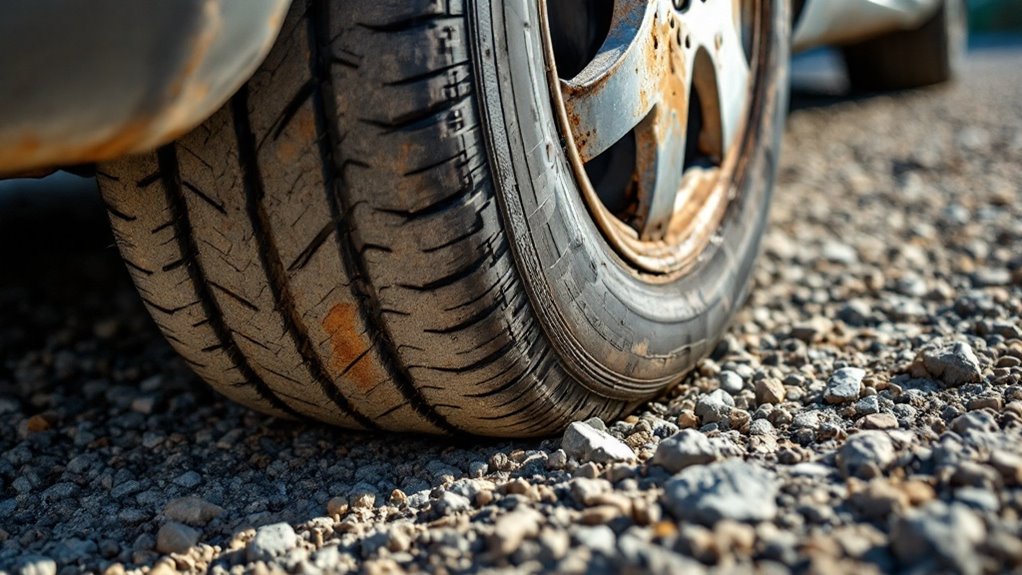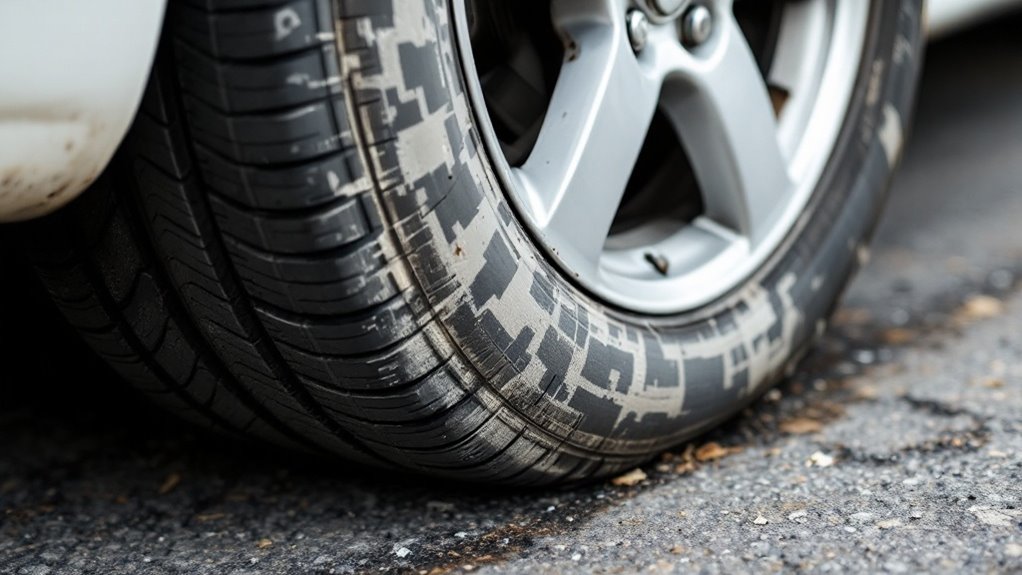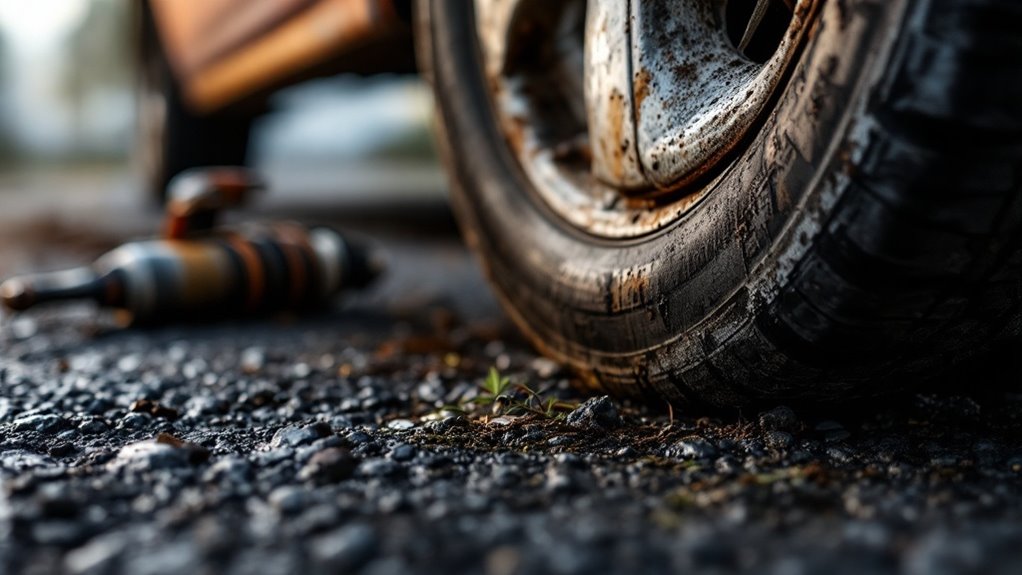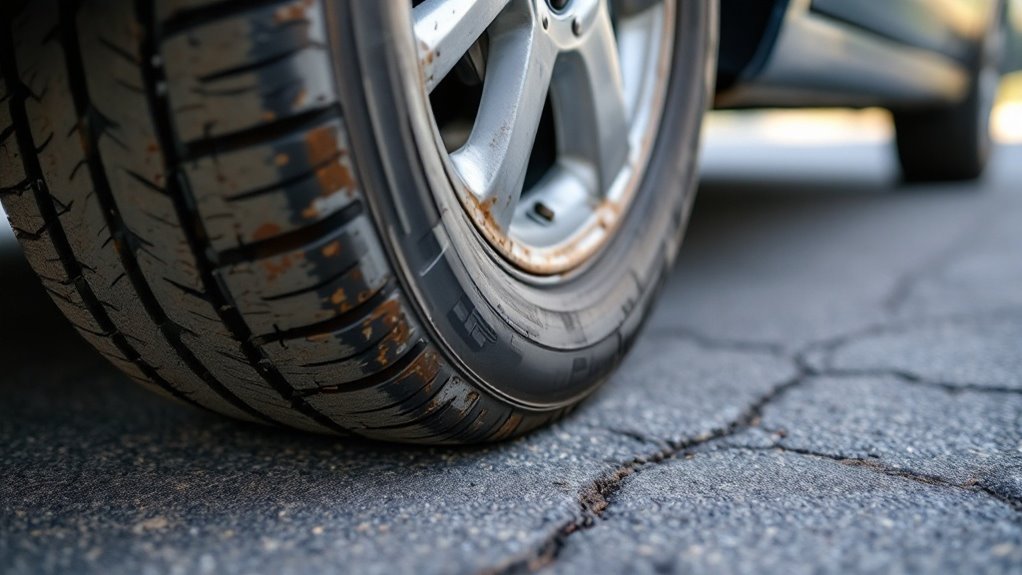Can Bad Shocks Cause Tire Wear
This post contains affiliate links. As an Amazon Associate, we earn from qualifying purchases.
Bad shocks can indeed lead to tire wear by failing to properly absorb road impacts, which causes uneven stress on tires. This can result in noticeable damage patterns like cupping or scalloping on tire treads. For a deeper understanding, further details and maintenance tips will be explored later in the article.
Essential Facts in 30 Seconds
- Bad shocks cause uneven tire wear, such as cupping, reducing grip and speeding up damage.
- Worn shocks disrupt wheel alignment, leading to increased tire stress and wear.
- Excessive bouncing from poor shocks results in inconsistent road contact and tire damage.
- Faulty shocks strain suspension components, further accelerating tire wear.
- Regular shock inspections help prevent uneven tire wear and prolong tire life.
Understanding the Role of Shocks in Vehicle Stability
Shocks are super important for keeping your car steady on the road. They help a lot, even if you don’t see them working. Shocks stop too much bouncing on bumpy roads. Think of gravel or streets full of holes. They make sure your car doesn’t shake too much.
Sharp turns or quick stops? Shocks control the car’s rolling and pitching. This keeps your ride smooth and safe. They help you steer better on twisty paths. Your tires stay glued to the road too. That’s key for tricky moves. Without proper shocks, you might notice uneven tire wear due to inconsistent road contact uneven tire wear. Additionally, bad shocks can exacerbate issues like poor vehicle handling, making it harder to control your car during sudden maneuvers.
Shocks also turn bumpy energy into heat. This cuts down shakes on rough highways. Check these cool perks:
- They cut body roll for safer turns.
- They lower shakes for better grip.
Here’s a quick look at their power:
| Job | How It Helps Stability |
|---|---|
| Shock Control | Cuts bounce on bumps |
| Car Handling | Boosts steering sharpness |
How Worn Shocks Lead to Uneven Tire Wear

Worn shocks on your car can mess up your tires fast. They cause uneven wear, which costs money and risks safety. Shocks that don’t work right stop tires from sticking to the road. This leads to weird wear patterns like cupping or scalloping. Rubber gets torn off in uneven chunks. Bad roads or wrong tire pressure make it worse. Newer cars with fancy suspensions suffer even more.
Let’s break down how worn shocks hurt your tires:
- Cupping Trouble: Rubber wears off unevenly, making tires bumpy.
- Spotty Road Grip: Tires bounce off the road, wearing out quicker.
- Extra Strain: Parts like ball joints take more damage.
- Faster Wear: Rough roads speed up the tire damage.
Check your shocks often to avoid these problems. Keep up with suspension care for safety. Regular checks spot issues early and save your tires. Worn shocks can also disrupt proper alignment, leading to additional tire stress. Disrupt proper alignment Additionally, improper alignment caused by bad shocks can accelerate wear on front tires faster due to increased friction and strain. Stay safe on the road with simple maintenance.
Identifying Symptoms of Damaged Shocks and Struts

Check your car for damaged shocks and struts with easy steps.
Listen for weird noises like clunking or knocking. These happen a lot on bumpy roads.
Feel for shakes in the steering wheel too. Even on smooth roads, tiny tremors mean trouble.
Watch how your car moves as well. Too much swaying or rolling in turns is bad.
Notice the front dipping hard when braking? That’s a big warning sign.
Damaged shocks mess up your ride fast. Fix them soon to stay safe!
Also, inspect for uneven tire wear, as this can indicate suspension effectiveness loss.
Keep an eye out for vibrations, which may suggest unbalanced tire issues.
Recognizing Noisy Suspension Issues
Got a noisy car? Let’s check if your suspension needs help. Strange sounds mean trouble. Pay close attention as you drive. Spotting these noises saves big problems. It keeps you safe too.
Look out for these signs:
- Clunking or Knocking: Worn bushings or ball joints cause this. Hear it over bumps.
- Squeaking or Squealing: Dry parts or old struts make this sound. Notice it on rough roads.
- Rattling Noises: Loose strut mounts or shocks create this. It ruins your ride.
- Grinding Sounds: Bad ball joints scream for quick fixes. Don’t wait on this.
Act fast with a good check. Data shows early repairs cut costs by 30%. Additionally, ignoring these noises can lead to uneven tire wear and compromise vehicle handling.
Fix issues now to avoid huge bills. Your safety matters most.
Noticing Steering Wheel Vibrations
Steering wheel vibrations are a big warning sign. Don’t ignore them! They often point to problems with tires or shocks.
At high speeds, these shakes can mean unbalanced tires. Damaged parts might also be the cause. This risks your safety on the road.
Shocks and struts play a key role. Worn shocks make vibrations worse. They also cause uneven tire wear. Fix this fast to stay safe. Data shows unbalanced tires lead to 30% more wear.
Use this simple checklist to help:
- Balance tires every 10,000 to 12,000 miles.
- Check shocks for any damage or wear.
- Ensure wheel alignment is correct.
Act now if you feel steady shakes. Keep your car running well. Your safety depends on it! Additionally, tire cupping from worn shocks can create uneven wear patterns on your tires, further compromising safety.
Observing Unusual Vehicle Movements
Spot unusual car movements while driving. They might mean trouble with shocks and struts. These parts keep your car steady and safe. Small issues can grow into big dangers. Act fast to stay safe on the road.
Look out for these warning signs:
- Too Much Lean: Your car tilts a lot in turns. This hurts control.
- Front Drops Low: The front dips hard when you brake. It feels unsafe.
- Rear Sinks Down: The back lowers too much when speeding up. Balance suffers.
- Bumpy Ride: The car keeps bouncing after bumps. Shocks may be worn out.
Stay alert to keep your car running well. Fix problems early for safety. Damaged shocks can also lead to uneven tire wear due to improper suspension balance.
Other Factors Contributing to Tire Wear Patterns

Tires wear out fast if wheels aren’t straight. Crooked wheels mess up weight balance. This causes heavy damage on tire edges. Even a tiny angle error hurts. Wrong tire pressure also ruins tires. Low pressure damages outer sides a lot. High pressure wears out the center tread. This makes driving risky and unsafe. Check out the table for clear details. It shows problems and easy fixes. Additionally, improper camber settings can accelerate uneven tire wear and reduce tire lifespan.
| Factor | Effect on Tire Wear | Solution |
|---|---|---|
| Crooked Wheels | Bad wear on edges from angles | Get wheels checked often |
| Wrong Tire Pressure | Damage on sides or center tread | Check pressure every month |
Misaligned Wheel Impact
Think about tire life. Misaligned wheels cause big problems for tires. They wear unevenly and fast. You might see damage on inner or outer edges. That shows alignment needs fixing.
Let’s break down the effects of misalignment:
- Camber Trouble: Negative camber harms inner edges. Positive camber hurts outer ones.
- Toe Problems: Toe-in wears outside edges. Toe-out ruins inside edges.
- Heel/Toe Damage: Bad alignment and no rotation make jagged tread.
- Big Impact: Wrong alignment cuts tire life. It lowers safety and efficiency.
Check alignment often. Keep your drive smooth and safe. Don’t wait for issues. Act now to save tires. Neglecting tire rotation can worsen uneven tire wear and accelerate damage from misalignment.
Incorrect Pressure Effects
Tire pressure matters a lot for your car’s safety and tire life. Wrong pressure causes uneven wear and shortens tire lifespan.
Underinflated tires wear out on the shoulders due to sidewall bending. Overinflated tires lose tread in the center from a small contact area. Low pressure also raises rolling resistance. This creates heat and damages rubber fast.
Think about these dangers! Underinflation plus heavy loads strain sidewalls and risk blowouts. Overinflation on fast roads wears the center tread quicker.
Check tire pressure every month. Match it to your car maker’s advice for load. Skipping this, especially in changing seasons, causes uneven tread.
Traction drops, and tire life cuts by up to 25%. Keep it right for safe drives! Driving with low tire pressure can significantly increase the risk of tire failure and accidents.
Effects of Poor Shocks on Overall Vehicle Performance

Poor shocks mess up your vehicle’s performance big time. They hurt handling and comfort on every ride. Bad shocks mean less control and more bouncing. Turns feel shaky, and sudden moves get risky. Crosswinds? They make things even worse!
Check out these key problems poor shocks cause:
- Unsteady Handling: Your car rolls and bounces too much. Control slips away fast.
- Harder Braking: Stopping takes longer with uneven weight. Crashes become more likely.
- Rough Rides: Expect bumpy trips and weird noises. Comfort just disappears.
- Extra Wear: Bad shocks stress other parts. Things break down quicker.
Don’t ignore this issue. Poor shocks risk your safety every day. They cut down your car’s life too. Fix them soon to stay safe! Additionally, bad shocks can lead to uneven tire wear patterns that reduce tire lifespan and affect vehicle stability.
Tips for Maintaining Shocks and Preventing Tire Damage

Keep your vehicle’s shocks in top shape for a safe ride. Bad shocks can harm tires and make driving bumpy. Check shocks often for leaks, rust, or damage. Spotting these early stops bigger problems. Hear odd noises or feel extra bouncing? Get a check right away.
Try these easy tips for better shock care. Always replace shocks in pairs on the same axle. This keeps balance and safety. Tighten bushings as the maker suggests. Proper alignment helps handling and saves tires.
Match factory specs during shock replacement. Look at other parts for wear too. Good shocks mean longer tire life. They also save fuel and cut repair costs. Enjoy a smooth, steady ride every day!
Frequently Asked Questions
Can Bad Shocks Affect Fuel Efficiency?
Bad shocks can really hurt your fuel efficiency. They make your car work harder. This burns more gas than needed. Think about it—poor shocks drag your ride down. Studies show bad shocks cut fuel economy by up to 2%. Fix them fast to save cash on gas. Check your shocks today for better mileage!
Do Worn Shocks Impact Wheel Alignment?
Got worn shocks? Don’t wait! They hurt your car’s suspension big time. Bad shocks mess up wheel alignment fast. This leads to uneven tire wear. Think about safety—shocks affect how your car handles. Replace them now to avoid costly fixes. Trust me, a small repair saves huge trouble!
Can Bad Shocks Cause Tire Blowouts?
Bad shocks can indeed lead to tire blowouts in an indirect way. They create extra stress on tires. Notice any bouncing or shaky rides? That’s a big warning sign! Poor shocks make tires wear out faster. Studies show worn shocks increase tire damage by 30%. Keep your ride safe and smooth. Check shocks often to avoid big problems. Tires last longer with good shocks. Don’t ignore those bumpy rides!
Are Bad Shocks Dangerous for Driving?
Did you realize that 1 in 5 cars has bad shocks? Worn shocks put you in danger. Notice bouncing or swaying while driving? That’s a risky sign! Bad shocks mess up your control on the road. Don’t wait for trouble to strike. Take action now—get them checked fast. Stay safe and keep your ride secure!
Do Shocks Affect Tire Rotation Patterns?
Got a question about shocks and tire rotation patterns? Absolutely, shocks play a big role! Bad shocks mess up tire tread. They cause uneven wear fast. Check your shocks often, okay? This keeps tires balanced and smooth. Data shows worn shocks cut tire life by 20%. Stay on top of it! Your tires will thank you.
Conclusion
Take a close look at your shocks often to keep them working well. Fix any damage fast to save your tires from uneven wear. Pay attention to warning signs and check them without delay. Bad shocks can ruin tires and make driving risky. Studies show worn shocks cause up to 20% more tire wear. Stay on top of things by replacing them as needed. Follow the maker’s advice for proper care every time. This helps your vehicle stay steady on any road. You also protect your money spent on tires and safety. Keep driving smooth and long-lasting with simple steps like these!
